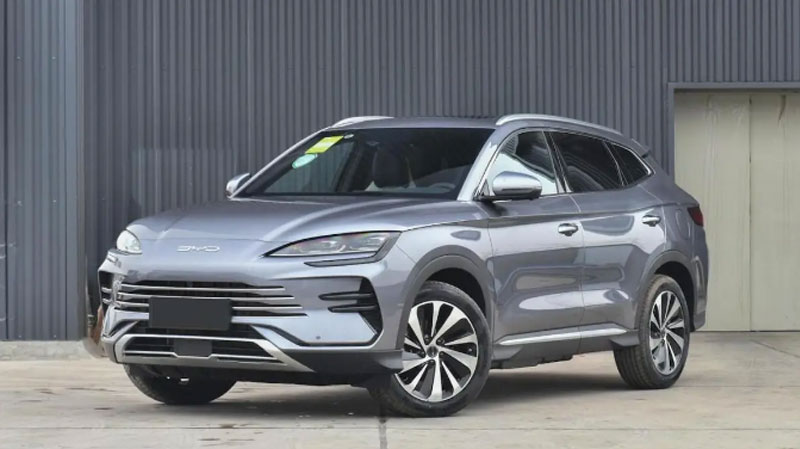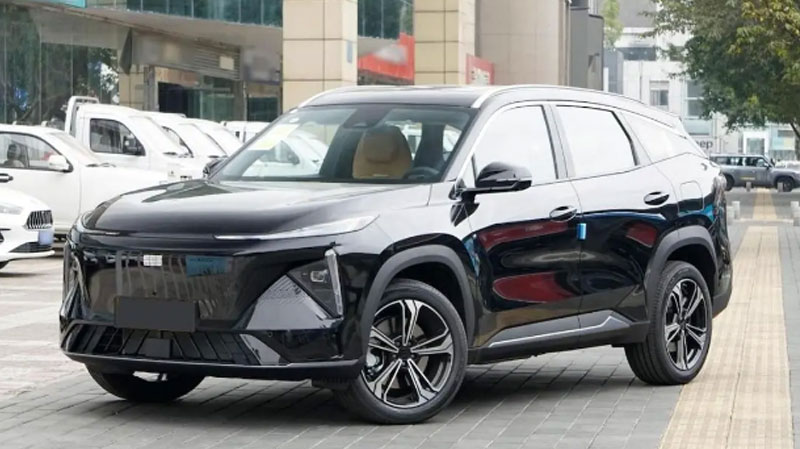Appearance
Both cars are visually attractive. Song PLUS has become bolder after undergoing a facelift. Some spoiler panels have been added to the part dominated by C-shaped air guides. Although the front of the car still has an It is mainly closed, the hollow banner is still in the banner style with the multi-layer spoiler below, forming a trapezoidal structure, which is visually richer. In addition, the special-shaped headlights at the front of the car and the slightly embedded through-type taillights at the rear can bring about full-layer changes.

The Galaxy L7 emphasizes some sci-fi effects. The entire front of the car is mainly a closed structure to optimize wind resistance. Only the trapezoidal lower air intake hole is retained in the front bumper position. It does not provide an independent rising sports guard like the Song PLUS; In the design of the headlights, the vehicle has been built in a split style. The upper part of the daytime running lights has completed the penetrating halo effect, and a small amount of parametric decoration has been added to the position of the diversion trough where the high and low beam lights are located. In addition, the rear of the vehicle has a slight tendency to sink, and the special-shaped through-taillights and large-sized diffused sports guards emphasize the movement.

In terms of size, Song PLUS has a length, width, and height of 4775/1890/1670mm and a wheelbase of 2765mm. It will be visually more slender than the Galaxy L7; while the Galaxy L7 is 4700/1905/1685mm, with a wheelbase of 2785mm. It is visually The upper part will appear wider.
Configuration
Song PLUS adopts a more obvious T-shaped fan layout. The steering wheel is three-spoke, the front layout has a 12.3-inch digital instrument panel, and the central control uses a suspended 12.8-inch rotatable touch screen. The whole is painted and metal trim. A double-layer decoration is formed. There is a short electronic gear handle under the air outlet of the central air conditioner. Air conditioning, multimedia, and some commonly used auxiliary functions will be presented on the shift mechanism in the form of touch, paddles, rollers, etc. Under high-level vision, it will still be Practicality is the main thing.

The Galaxy L7 adopts an asymmetric layout with a center of gravity deflection. The steering wheel is a more avant-garde four-spoke color contrast and inherits the electronic gearbox. The front layout has a 10.25-inch digital instrument panel, and the central control is facing the main driver’s side. It is equipped with a 13.2-inch touch screen, and the air-conditioning outlet adopts a thorough design arranged under the center console. The entire center control is connected to the panel through upper and lower layers to form a stronger sense of envelopment, and the 16.2-inch touch screen on the passenger side control screen will also make the entire cockpit look more technological.
In other aspects that improve the cabin environment, both cars have large panoramic sunroofs and provide lighting for the vanity mirrors. Among them, Song PLUS will have ambient lights to participate in decoration, and touch-sensitive reading lights to participate in lighting, and layout There is one more speaker (9 in total), and the functional details should be better.
Intelligent Technology
Both cars are equipped with intelligent interconnected vehicle systems. Among them, Song PLUS’s DiLink has not been updated to the latest version, but its dual-zone intelligent voice interaction and mobile APP can still achieve richer functional control coverage, and the latter can cover terms of doors/windows/air conditioning, etc.; the Galaxy N OS of the Galaxy L7 puts more emphasis on online functions and entertainment support, and it is adapted to the Qualcomm Snapdragon 8155 chip, which will be better in terms of richness and smoothness. The original mobile phone interconnection is also retained to meet the specific needs of different users.

Although both cars provide panoramic images with a transparent chassis and achieve safety assistance through multiple sets of radars and cameras, even Song PLUS has an anti-rollover system more common in off-road vehicles. However, Galaxy L7 is the first to implement L2-level assisted driving, including active braking, lane departure warning, lane centering, road traffic sign recognition feedback, etc., which will make it safer and easier to open.
Comfortable and convenient
The advantage of Song PLUS is that it achieves a better comfortable environment through front-row soundproof glass, rear privacy glass, and dual-temperature zone air conditioning that can monitor and purify air quality. However, its seats only support the main driver 6 The Galaxy L7 has a comfort advantage directly on the seats. The front rows support 6-way electric adjustment and heating. Among them, the main driver also supports ventilation and massage, and the co-pilot provides independent leg rests. In addition, its induction wipers and adaptive high and low beams will also make using the car safer and more convenient.
Mechanical aspects
Song PLUS is equipped with the DM-i super hybrid system. With the assistance of the SnapCloud plug-in hybrid 1.5L dedicated engine, the EHS145 electric hybrid system (motor power is 145kW), and the 18.3kWh blade battery, the vehicle can break 100km/h in 8.3 seconds. It also has a WLTC pure electric range of 85km, and the feed fuel consumption is also maintained at 5.3L/100km; in addition, 18kW fast charging takes one hour and supports a 3.3kW external discharge function.
The Thor 8848 power system of the Galaxy L7 is equipped with a 1.5T hybrid-specific engine, matched with a 3-speed variable frequency electric drive DHT Pro (motor power of 107kW) and an 18.7kWh CATL CTP flat battery. It uses a P1+P2 dual motors scheme, the system’s comprehensive power reaches 287kW and the comprehensive torque is 535N·m, allowing the vehicle to break 100km/h in 6.9 seconds. It has a 90km WLTC pure electric range and at the same time, the feed fuel consumption is also controlled at 5.23L/100km, and fast charging Only takes 0.5 hours. Overall, apart from being unable to discharge 3.3kW, Galaxy L7 is superior in terms of performance and efficiency.
In the chassis, both cars use a combination of front MacPherson and rear multi-link independent suspension, but the adjustment of Song PLUS will focus on more control and stability, while the Galaxy L7 will be slightly stiffer to support the vehicle. Motion control.
Summarize
Overall, BYD Song PLUS DM-i will be a more practical vehicle for families, and its appearance and interior will be more easily accepted by consumers of a wide range of age groups. The Galaxy L7 will obviously put more emphasis on the fun of using the car, and the overall youthfulness will be better. However, it falls at a critical stage. With the advantages of intelligent assistance already realized, its Thor 8848 electric hybrid system can Gain an advantage in overall performance will make us prefer the Galaxy L7 in our recommendations.
 hongjiauto
hongjiauto